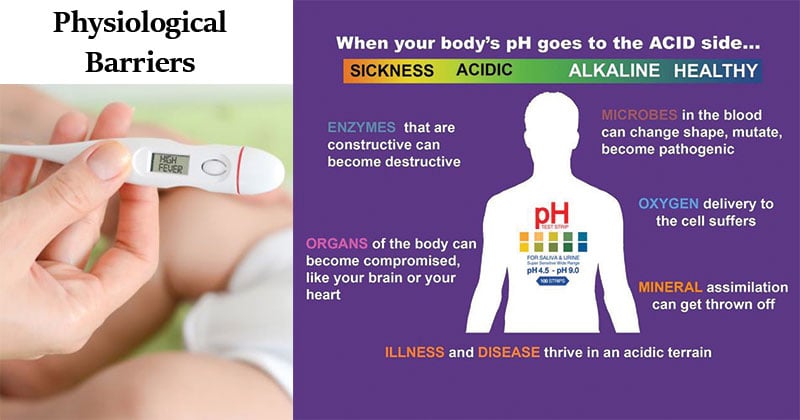- The simplest way to avoid infection is to prevent the microorganisms from gaining access to the body.
- Anatomical and physiological barriers together provide this crucial first line of defense against pathogens.
- Physiological barriers that contribute to the innate immunity are the body temperature, pH and various soluble secretory products of the mucosa.

Interesting Science Videos
A. Body temperature
While normal body temperature of 37oC inhibit the growth of some microbes, body temperature, especially fever, limits or prevents the growth of many microbes, especially viruses. In addition, the immune response is more efficient at elevated temperatures of the body.
B. pH
The acidic environment of the stomach, bladder, and kidneys and the bile of the intestines inactivate many viruses and bacteria. Various body tissues are protected by the low pH environment created by acid production.
- In the skin, many residing organisms break down lipids into free fatty acids contributing to the acidity of the skin (pH 5.5).
- Gastric acidity inhibits most of the microbes in the stomach due to the imparted acidity by gastric HCl (pH 1-3).
- The low pH of the female genital tract of about 4.4 due to the presence of lactic acid producing bacteria (normal flora) is inhibitory to most pathogens.
C. Secretory products of the mucosa
- Saliva and Mucous consist of enzymes in saliva damage the cell wall and cell membrane of bacteria.
- Tears contain lysozyme that destroys the peptidoglycan layer in bacterial cell wall causing its lysis. The continuous washing of the eye with tears containing lysozyme generally prevents the growth of microorganisms in the eye.
- Gastric juice: The HCI present in the gastric juice kills microbes by its low pH.
- Trypsin hydrolyzes bacterial protein causing cell lysis.
- Bile salts interfere with bacterial cell membrane causing destruction. Bile salts have both cytotoxic and bacteriostatic properties.
- Fatty acids denature the bacterial protein and also render an acidic environment where it is present inhibiting bacteria.
- Sebum forms a protective acid film over the skin surface that inhibits the growth of many microbes.
- Spermine and zinc present in semen inhibit the growth of gram-positive bacteria.
- Lactoferrin which is widely represented in various secretory fluids, such as milk, saliva, tears, and nasal secretions binds to iron, thus interferes with the acquisition of iron by bacteria.
- Colostrum contains immunoglobulins and lactoferrins which protect against bacterial proliferation and growth.
The physiological barriers of the body may also include the processes that occur in response to pathogens in order to remove them from the system.
- Peristalsis: The progressive and rhythmic contraction of the intestine traps microorganisms in mucus or other materials present in the intestine and expels them from the body.
- Urination: The flushing action of the slightly acidic urine helps maintains sterility of the urinary tract.
- Coughing and Sneezing: Reflexes such as coughing and sneezing remove trapped organism and help in their clearance from the system.
- Diarrhea and Vomiting are also mechanisms to clear out the infectious agent or substance out of the system.
References
- Brooks, G. F., Jawetz, E., Melnick, J. L., & Adelberg, E. A. (2010). Jawetz, Melnick, & Adelberg’s medical microbiology. New York: McGraw Hill Medical.
- Lydyard, P.M., Whelan,A.,& Fanger,M.W. (2005).Immunology (2 ed.).London: BIOS Scientific Publishers.
- Owen, J. A., Punt, J., & Stranford, S. A. (2013). Kuby Immunology (7 ed.). New York: W.H. Freeman and Company.
- Parija S.C.(2012). Textbook of Microbiology & Immunology.(2 ed.). India: Elsevier India.
- Sastry A.S. & Bhat S.K. (2016). Essentials of Medical Microbiology. New Delhi : Jaypee Brothers Medical Publishers.

This is highly educative.